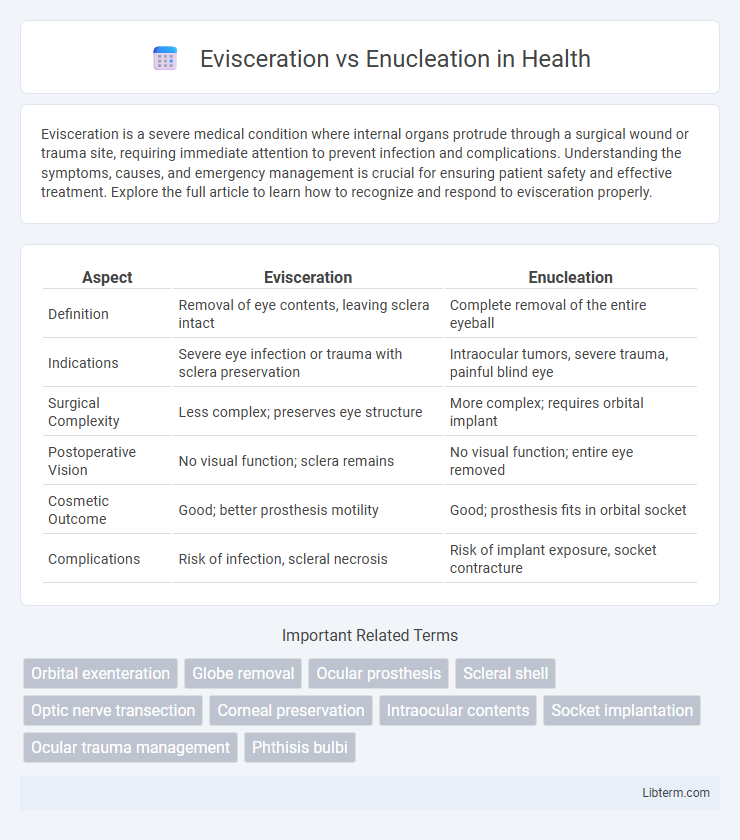Evisceration is a severe medical condition where internal organs protrude through a surgical wound or trauma site, requiring immediate attention to prevent infection and complications. Understanding the symptoms, causes, and emergency management is crucial for ensuring patient safety and effective treatment. Explore the full article to learn how to recognize and respond to evisceration properly.
Table of Comparison
| Aspect | Evisceration | Enucleation |
|---|---|---|
| Definition | Removal of eye contents, leaving sclera intact | Complete removal of the entire eyeball |
| Indications | Severe eye infection or trauma with sclera preservation | Intraocular tumors, severe trauma, painful blind eye |
| Surgical Complexity | Less complex; preserves eye structure | More complex; requires orbital implant |
| Postoperative Vision | No visual function; sclera remains | No visual function; entire eye removed |
| Cosmetic Outcome | Good; better prosthesis motility | Good; prosthesis fits in orbital socket |
| Complications | Risk of infection, scleral necrosis | Risk of implant exposure, socket contracture |
Introduction to Ocular Surgical Procedures
Evisceration involves removing the eye's contents while preserving the scleral shell and extraocular muscles, often favored for reducing infection and enhancing prosthetic mobility; enucleation entails complete removal of the eyeball, including the globe, but retains the orbital tissues for implant placement. Both surgical procedures address severe ocular trauma, tumors, or painful blind eyes, with the choice influenced by underlying pathology and desired cosmetic outcome. Understanding indications, procedural differences, and postoperative care is essential in ocular surgery to optimize patient recovery and prosthetic integration.
Defining Evisceration and Enucleation
Evisceration involves the surgical removal of the eye's internal contents while leaving the scleral shell and extraocular muscles intact, preserving the outer structure. Enucleation refers to the complete removal of the entire eyeball, including the globe along with a portion of the optic nerve, typically performed for severe trauma, malignancies, or painful blind eyes. Both procedures address different clinical needs and are critical in ocular oncology, trauma management, and end-stage ocular disease treatments.
Indications for Evisceration
Evisceration is primarily indicated in cases of endophthalmitis unresponsive to medical treatment, painful blind eyes, or severe ocular trauma where the sclera remains intact and can support an implant. It is preferred when intraocular contents need removal but orbital volume preservation and better prosthetic motility are desired. Contraindications include intraocular tumors or extensive scleral damage, where enucleation is indicated instead.
Indications for Enucleation
Enucleation is primarily indicated for intraocular tumors such as retinoblastoma or malignant melanoma, severe ocular trauma resulting in a blind and painful eye, and end-stage eye diseases where other treatments have failed. It is favored when preservation of the ocular structure is impossible and there is a risk of sympathetic ophthalmia or spread of malignant cells. This surgical removal of the entire eyeball differs from evisceration, which involves removing intraocular contents but preserving the scleral shell.
Key Differences Between Evisceration and Enucleation
Evisceration involves removing the eye's internal contents while preserving the scleral shell and extraocular muscles, allowing for better prosthetic motility. Enucleation entails complete removal of the eyeball, including the sclera, which may be necessary in cases of intraocular malignancy or severe trauma. The choice between evisceration and enucleation depends on clinical factors like infection presence, tumor involvement, and cosmetic outcome requirements.
Surgical Techniques: Step-by-Step Comparison
Evisceration involves the removal of the eye's internal contents while preserving the scleral shell and extraocular muscles, typically starting with a circumferential peritomy followed by careful evacuation of intraocular tissues and implantation of an orbital implant within the scleral shell. Enucleation entails complete removal of the globe, beginning with severing the extraocular muscles and optic nerve to excise the entire eyeball, often followed by implant placement and closure of Tenon's capsule and conjunctiva. Both techniques require meticulous hemostasis and attention to orbito-ocular anatomy to optimize implant integration and postoperative cosmesis.
Clinical Outcomes and Complications
Evisceration preserves the scleral shell and extraocular muscles, often resulting in faster prosthetic motility and improved cosmetic outcomes compared to enucleation, which involves removal of the entire eyeball. Clinical outcomes reveal that enucleation may be preferred in cases with intraocular malignancy or severe ocular trauma to reduce the risk of sympathetic ophthalmia, while evisceration carries a slightly higher risk of orbital implant exposure and infection. Both procedures have comparable rates of postoperative complications such as socket contracture and implant extrusion, though careful patient selection and surgical technique significantly influence prognosis.
Cosmetic Results and Patient Satisfaction
Evisceration typically offers better cosmetic results compared to enucleation due to the preservation of the scleral shell, allowing for a more natural eye movement and improved prosthetic fit. Patient satisfaction rates are generally higher with evisceration since the procedure maintains orbital volume and reduces the risk of implant migration, leading to a more comfortable and aesthetically pleasing outcome. Enucleation, while necessary in severe pathologies, often results in a less dynamic prosthesis and may require additional interventions to optimize cosmetic appearance.
Postoperative Care and Rehabilitation
Postoperative care after evisceration involves managing orbital socket inflammation and ensuring proper fitting of the ocular prosthesis to promote comfort and aesthetic restoration. Enucleation requires careful monitoring for socket contracture and implant integration, with frequent follow-ups to optimize prosthetic mobility and prevent complications like implant exposure. Rehabilitation for both procedures emphasizes tailored ocular prosthesis training and psychological support to address adaptation challenges and improve quality of life.
Choosing the Appropriate Procedure
Choosing the appropriate procedure between evisceration and enucleation depends on the extent of ocular damage and the presence of intraocular disease. Evisceration, which removes the eye's contents while preserving the scleral shell, is often preferred for blind, painful eyes without infection. Enucleation involves removing the entire eyeball and is indicated in cases of intraocular tumors, severe trauma, or when evisceration is contraindicated to prevent disease spread.
Evisceration Infographic

 libterm.com
libterm.com